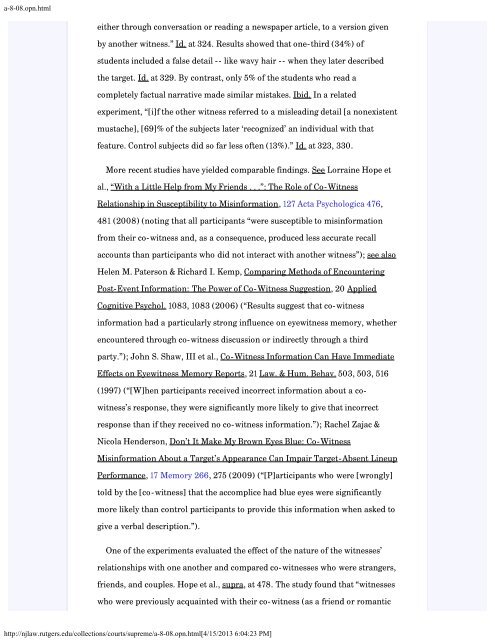State v. Henderson and the New Model Jury Charges - New Jersey ...
State v. Henderson and the New Model Jury Charges - New Jersey ...
State v. Henderson and the New Model Jury Charges - New Jersey ...
Create successful ePaper yourself
Turn your PDF publications into a flip-book with our unique Google optimized e-Paper software.
a-8-08.opn.html<br />
ei<strong>the</strong>r through conversation or reading a newspaper article, to a version given<br />
by ano<strong>the</strong>r witness.” Id. at 324. Results showed that one-third (34%) of<br />
students included a false detail -- like wavy hair -- when <strong>the</strong>y later described<br />
<strong>the</strong> target. Id. at 329. By contrast, only 5% of <strong>the</strong> students who read a<br />
completely factual narrative made similar mistakes. Ibid. In a related<br />
experiment, “[i]f <strong>the</strong> o<strong>the</strong>r witness referred to a misleading detail [a nonexistent<br />
mustache], [69]% of <strong>the</strong> subjects later ‘recognized’ an individual with that<br />
feature. Control subjects did so far less often (13%).” Id. at 323, 330.<br />
More recent studies have yielded comparable findings. See Lorraine Hope et<br />
al., “With a Little Help from My Friends . . .”: The Role of Co-Witness<br />
Relationship in Susceptibility to Misinformation, 127 Acta Psychologica 476,<br />
481 (2008) (noting that all participants “were susceptible to misinformation<br />
from <strong>the</strong>ir co-witness <strong>and</strong>, as a consequence, produced less accurate recall<br />
accounts than participants who did not interact with ano<strong>the</strong>r witness”); see also<br />
Helen M. Paterson & Richard I. Kemp, Comparing Methods of Encountering<br />
Post-Event Information: The Power of Co-Witness Suggestion, 20 Applied<br />
Cognitive Psychol. 1083, 1083 (2006) (“Results suggest that co-witness<br />
information had a particularly strong influence on eyewitness memory, whe<strong>the</strong>r<br />
encountered through co-witness discussion or indirectly through a third<br />
party.”); John S. Shaw, III et al., Co-Witness Information Can Have Immediate<br />
Effects on Eyewitness Memory Reports, 21 Law. & Hum. Behav. 503, 503, 516<br />
(1997) (“[W]hen participants received incorrect information about a cowitness’s<br />
response, <strong>the</strong>y were significantly more likely to give that incorrect<br />
response than if <strong>the</strong>y received no co-witness information.”); Rachel Zajac &<br />
Nicola <strong>Henderson</strong>, Don’t It Make My Brown Eyes Blue: Co-Witness<br />
Misinformation About a Target’s Appearance Can Impair Target-Absent Lineup<br />
Performance, 17 Memory 266, 275 (2009) (“[P]articipants who were [wrongly]<br />
told by <strong>the</strong> [co-witness] that <strong>the</strong> accomplice had blue eyes were significantly<br />
more likely than control participants to provide this information when asked to<br />
give a verbal description.”).<br />
One of <strong>the</strong> experiments evaluated <strong>the</strong> effect of <strong>the</strong> nature of <strong>the</strong> witnesses’<br />
relationships with one ano<strong>the</strong>r <strong>and</strong> compared co-witnesses who were strangers,<br />
friends, <strong>and</strong> couples. Hope et al., supra, at 478. The study found that “witnesses<br />
who were previously acquainted with <strong>the</strong>ir co-witness (as a friend or romantic<br />
http://njlaw.rutgers.edu/collections/courts/supreme/a-8-08.opn.html[4/15/2013 6:04:23 PM]
















